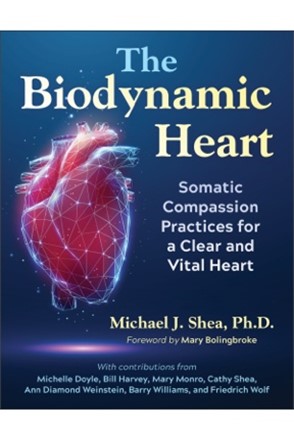- Home
- Editor's Notes
- Current Issue
- Riki Reflects
- Spiritual Traveler
- Starz Emporium
- Classifieds
- Advertise with Us
- Submissions
- Awards
- About Us
- Contact Us
The Biodynamic Heart
By Michael J. Shea, Ph.D.
 INTRODUCTION
The Four Intentions The first intention of this book is to save lives. Following the publication of my previous book, The Biodynamics of the Immune System, I was interviewed many times and always asked the same question: Why did I write the book? My answer was simple and, for some of the interviewers, surprising: to save lives. That same intention inspired this book, The Biodynamic Heart. While setting out to save lives is altruistic, and certainly the intention is to see our world with more compassion, through the process of writing I came to realize that this work is also about saving my own life. The reader will see, starting with chapter 1, how I narrowly escaped death and the work I have subsequently put in to save my own life by every means possible. I have received a lot of love and support along the way, especially from the infants and children I worked with. It is by saving my own life that I can share my learning that can save other lives. The second intention is to teach practitioners and all health care providers that biodynamic cardiovascular therapy (BCVT) is a ministry of laying on of hands. It is a ministry of using our hands to bless every client. The terminology used in biodynamic practice lends itself to mysticism and direct experience of the sacred regardless of religious affiliation. We can no longer avoid this reality, as many clients cannot make the changes necessary to relieve their metabolic syndrome and thus biodynamic work becomes palliative care in which we make our offering and our blessing for its potential to assist the client in waking their instinct for self-transcendence. Through palliative care, we help clients bear their sorrow and joy. This is the work of compassion and the essence of this book. The felt sense of sorrow is warmth and coziness. It is the music of the heart. It exists on a continuum with joy, the felt sense of brightness and clarity. It is with contemplative practice that sorrow and joy become a single continuum. They are as inseparable as the different movements in a piano concerto. They are inseparable because neither state is superior or inferior to the other. In its essence of infinite equality, the present moment of awareness, awakened by contemplative practice, provides this insight of beauty that is always there, waiting to be recognized and remembered as the preexisting condition of life and death. This is the deeper meaning of biodynamic practice. This is a book about multifaith spirituality rather than furthering concepts about God, male or female, who lives in the natural world or heaven, and whose depictions are based on the need of different cultures and the fashion of the times. The premise of this book is that everyone can experience their very subtle nature and essence of spirituality as clear light, color, and form without fear. These are the doorways that contemplative practice provides so that we can experience essence and spirit. Such metaphors are still conceptual, though, and deep contemplative practice allows the disappearance of concept, leaving the felt sense of sorrow and joy. Contemplative practice is about turning inward and learning to love one’s self by feeding oneself internally as the basis for being a compassionate, social human being. Said another way, the second intention of this book is to view biodynamic practice as spiritual practice based on the emerging field of contemplative neuroscience. The third intention is to help readers form a contemplative relationship with their thoughts, emotions, concepts, and life views. To recognize, reframe-release, and relax mental and emotional afflictions are the skills necessary for spiritual resilience. Contemplative practice invokes each individual’s spiritual formation and leads to spiritual maturation. Gradually spiritual maturation fulfills itself as direct knowing of the sacred without an interpreter. This book provides a framework for a multifaith direct knowing of the sacred. Contemplative practice is the key to self-transcendence of self and other. The purpose of contemplative practices is, first, to be able to recognize challenging or disruptive internal states of mind associated with thoughts, emotions, concepts, and views. Such recognition comes through mindfulness and awareness practices. Next, upon recognition, there is an immediate reframing or empathetic response to one’s own internal state. Finally, one simply relaxes into such freedom that contemplative practice gives by the enhancement of nonreferential awareness and nonattachment to internal states. Over time this type of contemplative practice develops spiritual resilience and allows thoughts, emotions, and concepts to reside in the heart, as they are transmuted into loving kindness and compassion. This is called heart-mind. In this way, contemplative practice is food for our heart. The fourth intention is to help readers feel the physical and spiritual nature of the human heart as one thing. The heartbeat and the stillpoint at the back of the heart are the home of our spiritual essence, the heart inside the heart. The overall intention of this book is to help readers find their heart, and to do this, we will discuss the heart in numerous ways, from the physical to the spiritual. OVERVIEW This book describes the categories of conceptual and spiritual knowing that support the professional practice of BCVT. BCVT is a contemplative manual therapeutic art form in which the priority is kindness and sublime gentleness radiating from the heart of the practitioner as light. BCVT is initiated by the application of biodynamic craniosacral therapy to the cardiovascular system. It integrates skills derived from Eastern and Western cosmologies and human embryology. It originates partly with Andrew Taylor Still, the late nineteenth-century founder of osteopathy, who said, “The rule of the artery is supreme.” This tradition was moved forward by William Garner Sutherland, a student of Still who claimed the osteopathic tradition to be religious or spiritual in its essence. Its core foundations further derive from all ancient animistic and shamanistic medical traditions. And as a ministry of laying on of hands, BCVT is derived from all spiritual traditions involving hands-on healing or “spiritist passe” (Carneiro, Moraes, and Terra 2016; Carneiro et al. 2017). Yet it is an emergent knowing rather than an eclectic or mixed-bag therapeutic approach for the contemporary client. This book elaborates a comprehensive set of perceptual and palpation competencies for the contemporary practitioner and client for integrating mind-body-spirit. The palpation skills are derived from a variety of sources including osteopathy and its derivatives, traditional cultural methods as just mentioned, and especially spontaneous knowing from contemplative practice. This book clarifies the core principles and scope of clinical practice for the international community of biodynamic practitioners, and especially biodynamic cardiovascular therapy practitioners, who are interested in the spiritual domain of making meaning around pain and suffering in the contemporary world, which faces significant civilizational issues. BCVT is a contemplative art form that explores a range of subtle motions, forms, and colors that are expressed within and around the body. A practitioner’s ability to visualize them is considered a spiritual aptitude, as is the ability to perceive stillness and Primary Respiration (PR). The exploration of these biodynamic spiritual aptitudes is associated with optimizing metabolic function. This book explores the Indo-Tibetan system of wisdom colors from which the elements of space, wind, fire, water, and earth emerge in the evolution of universes big and small. BCVT further differentiates the use of yogic mudras, classical Chinese medicine meridians, and the Sino-Tibetan system of elements. BCVT creates bridges to ancient systems of healing that recognize the innate unity of mind-body-spirit in all sentient beings. Consequently, BCVT practitioners are expected to cultivate a personal contemplative practice that supports their spiritual maturation and leads to a direct experience of the sacred. There is a need for an inner practice to develop emotional resilience and an outer practice that connects practitioners to the natural world as both sentient and medicinal. I introduce biodynamic healing practices that apply to both the client and the practitioner’s spiritual formation without dogma. This traditional medical capacity predates all formal Eastern and Western medical practices. BCVT is animistic-shamanistic, mystical, and practical without romanticizing traditional ways of knowing and healing or politicizing its origins. No one has the right to claim dominion over such healing practices. The emphasis in BCVT is for practitioners to hold themselves and their client as an interconnected whole extending to the horizon in order to harmonize the forces of Health in the natural world with the inner forces of Health that organize the subtle body with the metabolism of structure and function. The inner and outer organization of Health is uniformly scaled across the universe as colors, their associated elements, and states of mental clarity. Practitioners synchronize their attention with the immutable Health that is preexisting inside and outside the human body as a single continuum ultimately free of a perceptual reference point. It can be called nonreferential awareness or God and numerous other metaphors because of a multifaith orientation in BCVT. Health in the context of a biodynamic session is the potency of PR, a deep wisdom expression of the wind and fire elements that drive all life expressions and the instincts discussed thoroughly in this book. All BCVT processes and life experiences are perceived from within a person’s heart and soma as a sacred center extending to the edge of the universe. All origins are located in the heart inside the heart of every sentient being. It is within this universal context of manifestation arising from subtle perception of the heart-mind of love that change process constantly takes place. This includes death and dying, since our body is constantly igniting its death at the cellular level. The inability to accept natural and constant change leads to disease. Author Bio: Michael J. Shea, Ph.D., holds a doctorate in somatic psychology from the Union Institute and has taught at the Upledger Institute, the Santa Barbara Graduate Institute, and the International University for Professional Studies. He is a founding board member of the Biodynamic Craniosacral Therapy Association of North America. He is the author of several books, including The Biodynamics of the Immune System, and lives in Juno Beach, Florida. https://www.sheaheart.com The Biodynamic Heart by Michael J. Shea, Ph.D., published by Inner Traditions International and Bear & Company, © 2025. All rights reserved. http://www.Innertraditions.com Reprinted with permission of publisher. |
Share this article with friends!
|
Copyright © 1998 - 2025 Mystic Living Today All rights, including copyright, in the content of these Mystic Living Today web pages are owned or controlled for these purposes by Planet Starz, Inc. Terms of Service Disclaimer and Legal Information For questions or comment, contact Starzcast@mysticlivingtoday.com. Reproduction of this page in any form is not allowed without permission of the author and the owner of this site. All material on this web site, including text, photographs, graphics, code and/or software, are protected by international copyright and trademark laws. Unauthorized use is not permitted. You may not modify, copy, reproduce, republish, upload, post, transmit or distribute, in any manner, the material on this web site. Unless permissions is granted. |



